The Masks of Venice - Traditional Guest Blog and Giveaway with Tonya Macalino

Hidden identities, secret intrigues, shadowy assignations.
Venice, once the golden seat for the conspiracies of an Adriatic empire, slowly declined into the European center of debauchery for generations of disillusioned wastrels flaunting the strictures of the world beyond its waters. By the time Alyse Kate Bryant steps into the island’s ruins in FACES IN THE WATER, Venicehas little more left than the legends of what she once was. But those legends grow restless and unwitting accomplices breathe life into those ruthless, hungry elemental powers ready to live again.
Hidden identities, secret intrigues, shadowy assignations.
The masks of Venicehave become a symbol of the city, a metaphor for her once darkly glittering splendor. Although associated with Carnival, Venetians clung to their masks, not just for that wild celebration, but to cast a veil of mystery over any number of machinations from gambling to dabbling with nuns to courting across class boundaries.
The traditional masks enter the history books in the 13thcentury as a cover for young men tossing perfume or rose water-filled eggs at ladies—something that had to be prohibited by law. As anything with such a long history, the masks have taken on symbolic traditions of their own.
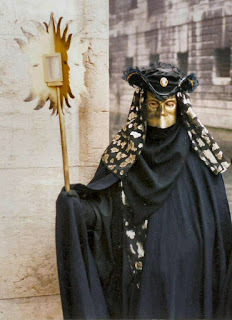
The Bauta
Possibly derived from the Veneto-Italian bogey man the “bau-bao” (although there are other theories), the traditional Bauta was a white full-coverage mask with a protruding lower half for ease of eating and drinking. It was typically worn by both genders with a tricorne hat and a black cloak.
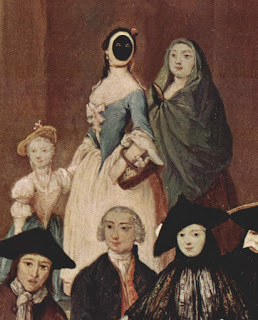 The Moretta
The Moretta
Known also as the Mute Maid Servant, the Moretta “Dark” mask was an oval mask of black velvet with eye holes, but no mouth, worn with a wide brimmed hat and/or a veil. The “silent” aspect arose from the fact that the wearer held the mask to her face by grasping a button between her teeth. The mask was often used by upper class women visiting convents.
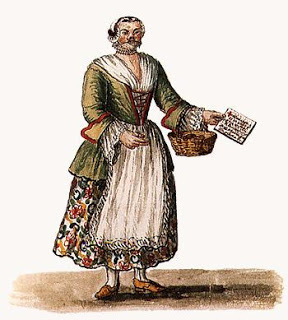 The Gnaga
The Gnaga
The Gnaga comprised of a small mask sometimes mimicking a woman’s features coupled with women’s dress and was most popularly used by young men seeking homosexual encounters. Some claim the name comes from the term “gnao” comparing the exaggerated falsettos employed with the costume to a cat’s meow.
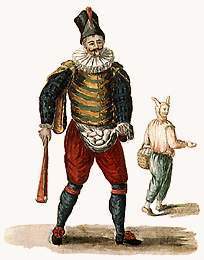 The Mattaccino
The Mattaccino
This was the mask favored by those men with their egg-launching slingshots. It is a clown-like mask and the costume generally included a pouch for carrying said eggs.
 The Volto or Larva
The Volto or Larva
The most typical Venetian mask, the “Larva” name may derive from the Latin for ghost. Volto simply means “face.” Originally, a partial mask, it now refers to the ubiquitous full-coverage mask.
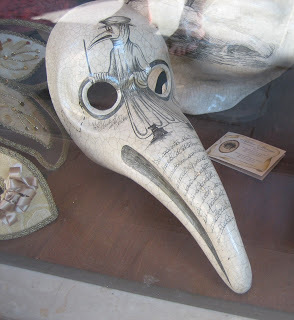 Mecio Della Peste
Mecio Della Peste
The Plague Doctor mask is a costume derived from the original sanitary mask of the plague doctors developed by Charles de Lorme in the 17thcentury. The original masks had crystal disks in the eye holes as well, causing them to look like they sported spectacles. The costume version usually includes the long black cloak and hat and the white stick used for handling patients.
Masks of the Commedia Dell’arte
Commedia Dell’arte contributed heavily to the look of Carnival, contributing the masks of its stock characters to the cast of revelers. Look for a guest post later in my blog tour to cover these masks. (Refer to my website at www.tonyamacalino.com/page3.phpon May 30th for the link.)
Thanks so much for the opportunity to drop by! If after reading all that, you feel the need for a Venetian fix, drop by Amazon or Barnes & Noble for a copy of FACES IN THE WATER and follow Alyse as she enters the magic and the mystery of the City of Masks.
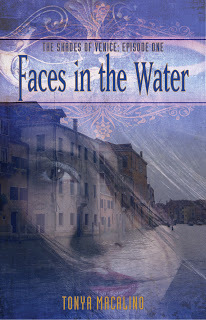 Faces in the Water
Faces in the Water
By Tonya Macalino
Who created that slide of silk across your skin as you reached for your cinematic lover? Who recorded the crushing weight of the grizzly as you fought for your life in the fictional wilderness? It is Lone Pine Pictures’ Alyse Kate Bryant who wraps your body in the story only your mind was privy to before.
A brilliant sensory immersion artist and a wild daredevil, Alyse will do almost anything for the perfect sensory file, but the violent death of her father has her teetering on the very edge of reckless sanity.
For just one night, Alyse seeks refuge in the arms of a beautiful stranger.
And her recklessness finally has consequences.
Now Alyse finds herself trapped in the flooded ruins of Venice, a quarantine camp for the carriers of Sleepers’ Syndrome. But it can never be that simple. Because the Sleepers’ Syndrome carriers who populate the camp are no longer as human as they seem.
The city of legend is bringing its legends back to life.
They come now, Alyse.
Run.
 About the Author
About the Author
Tonya Macalino lives in Hillsboro, Oregon with her husband and two children. She is an avid collector of folklore and folk history, far too many to fit comfortably within the pages of any given book. When not working on her latest novel, she enjoys coaching other writers through the How to Build a Book workshops at Jacobsen’s Books & More. To read more of the little folklore gems she unearthed during her research, please visit her blog at www.tonyamacalino.com
For news and events, drop by her Facebook page at www.facebook.com/TonyaMacalino.com
The Story of Place Blog: www.tonyamacalino.com/page10.php
Amazon Author Page:
http://www.amazon.com/Tonya-Macalino/e/B0058U4TJA/ref=ntt_athr_dp_pel_1
Shelfari: www.shelfari.com/tonyamacalino
Goodreads: www.goodreads.com/tonyamacalino
Twitter: https://twitter.com/#!/TonyaMacalino
Pintrest: http://pinterest.com/tonyamacalino/ a Rafflecopter giveaway<a href="http://rafl.es/enable-js"&am... need javascript enabled to see this giveaway</a>.
Published on May 09, 2012 21:30
No comments have been added yet.



